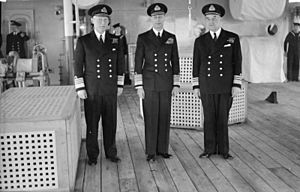Lumley Lyster facts for kids
Quick facts for kids
Sir Lumley Lyster
|
|
|---|---|
| Born | 27 April 1888 Coleshill, Warwickshire |
| Died | 4 August 1957 (aged 69) Charminster, Dorset |
| Allegiance | United Kingdom |
| Service/ |
Royal Navy |
| Years of service | 1902–1945 |
| Rank | Vice Admiral |
| Commands held | Fifth Sea Lord (1941–42) HMS Glorious (1937–39) 5th Destroyer Flotilla (1933–35) HMS Exmouth (1934–35) HMS Wallace (1933–34) HMS Despatch (1932–33) HMS Danae (1931–32) |
| Battles/wars | |
| Awards | Knight Commander of the Order of the Bath Commander of the Royal Victorian Order Commander of the Order of the British Empire Distinguished Service Order Mentioned in Despatches Order of the Crown of Italy |
Sir Arthur Lumley St George Lyster was a very important officer in the Royal Navy. He was a Vice Admiral and played a big role during the Second World War. He was born on April 27, 1888, and passed away on August 4, 1957.
Contents

Lumley Lyster started his naval journey in 1902. He joined a special training ship called HMS Britannia. This was where young people learned to become officers in the Royal Navy.
After his training, he served on different ships. In 1912, he decided to focus on gunnery. This meant he became an expert in how to use and aim the big guns on warships. He trained at HMS Excellent, a famous gunnery school.
Serving in World War I
Lyster saw action during the First World War. His ship fought in the Gallipoli campaign in 1915. This was a very tough battle.
Key Commands and Roles
After the First World War, Lyster continued to rise through the ranks. He commanded several ships, including the cruiser HMS Danae in 1932. He also led a group of destroyers, called the 5th Destroyer Flotilla, starting in 1933.
He then became the director of training for the Royal Navy in 1936. This meant he helped decide how sailors and officers were trained. In 1937, he took command of the aircraft carrier HMS Glorious. Aircraft carriers are huge ships that carry many airplanes.
Helping the King
In 1939, Lyster was made an Aide-de-camp to King George VI. This was a special role where he helped the King with his duties.
World War II Contributions
When the Second World War began, Lyster was in charge of the Royal Navy's dockyard at Scapa Flow. This was a very important naval base.
Planning the Taranto Attack
From 1940, Lyster became the rear-admiral in charge of aircraft carriers in the Mediterranean Fleet. He is famous for planning a daring attack called the Battle of Taranto. This plan was actually started in 1935. In November 1940, his plan was put into action. British planes launched from aircraft carriers attacked Italian warships in their harbor at Taranto. This was a very successful attack.
Later War Service
In 1941, Lyster was given an even bigger role. He became the Fifth Sea Lord. This meant he was a top leader in the Royal Navy, specifically in charge of naval air services. He also commanded the aircraft carriers in the Home Fleet.
In 1942, he led air operations during Operation Pedestal. This was a vital mission to deliver supplies to the island of Malta. For his bravery and leadership, he received an award called the Commander of the Order of the British Empire.
Lyster's last job before retiring in 1945 was as Flag Officer, Carrier Training. He helped train new officers for aircraft carriers.

